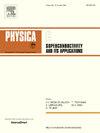Numerical simulation of damage and critical current degradation behaviors of RRP and PIT Nb3Sn wires under transverse pressure
IF 1
3区 物理与天体物理
Q4 PHYSICS, APPLIED
Physica C-superconductivity and Its Applications
Pub Date : 2025-07-10
DOI:10.1016/j.physc.2025.1354751
引用次数: 0
Abstract
The state-of-the-art Nb3Sn wire still exhibits discrepancies in both mechanical and superconducting critical properties when juxtaposed with the target of the requirement for superconducting wire set for future circular colliders (FCC). Intensive efforts are currently underway to develop high performance Nb3Sn wires with enhanced mechanical and superconducting properties. In parallel, developing convenient and efficient numerical methods for comprehensively evaluating the mechanical and superconducting properties of various Nb3Sn wires is of critical significance. Given the relevant context, the analysis of critical current degradation and fracture damage behavior of Nb3Sn superconducting wires under transverse pressure is of significant importance. In this paper, the detailed strand numerical models are established based on the meso‑structure characteristics of Restacked-Rod-Process (RRP) and Powder-in-tube (PIT) Nb3Sn wires at first. These models can be used to simulate stress distribution and mechanical behaviors under various external loading conditions. Subsequently, the damage and superconducting critical current degradation of epoxy-impregnated RRP and PIT wires under transverse pressure are evaluated in numerical simulations, taking into account the irreversible degradation caused by the residual plastic stress of the annealed copper matrix. This numerical method encodes all superconducting filaments/sub-elements of the two-dimensional numerical model by considering the periodic positional changes of the twisted filaments/sub-elements along the wire axis. The results indicate that within a transverse pressure range of 100 to 200 MPa, the plastic residual stress of the copper matrix is the primary cause of irreversible critical current degradation. At transverse pressure exceeding 200 MPa, the influence of damage on the critical current cannot be ignored due to the emergence of damage. When the transverse pressure reaches 413 MPa, through-thickness damage has occurred in the Nb3Sn phase of all types RRP and PIT wires. Compared to PIT B215 wires, the critical current of RRP 108/127 wires have better strain tolerance. The numerical method with a low computational burden in this paper can conveniently evaluate the fracture and damage as well as degradation of critical properties of various Nb3Sn wires under transverse pressure.
横向压力下RRP和PIT Nb3Sn导线损伤及临界电流退化行为的数值模拟
当与未来圆形对撞机(FCC)超导线组要求的目标并置时,最先进的Nb3Sn线在机械和超导临界性能方面仍然表现出差异。目前正在加紧努力开发具有增强机械性能和超导性能的高性能Nb3Sn线。同时,开发方便、高效的数值方法来综合评价各种Nb3Sn线的力学性能和超导性能具有重要意义。在此背景下,分析Nb3Sn超导导线在横向压力下的临界电流退化和断裂损伤行为具有重要意义。本文首先基于再堆棒工艺(RRP)和管内粉末(PIT) Nb3Sn线的细观结构特征,建立了详细的线束数值模型。这些模型可用于模拟各种外载荷条件下的应力分布和力学行为。在此基础上,考虑了铜基体残余塑性应力的不可逆退化,通过数值模拟研究了环氧浸渍RRP线和PIT线在横向压力下的损伤和超导临界电流退化。该数值方法通过考虑扭曲丝/子单元沿线轴的周期性位置变化,对二维数值模型中的所有超导丝/子单元进行编码。结果表明:在100 ~ 200 MPa的横向压力范围内,铜基体的塑性残余应力是导致临界电流不可逆退化的主要原因;在横向压力超过200 MPa时,由于损伤的出现,损伤对临界电流的影响不容忽视。当横向压力达到413 MPa时,各类型RRP和PIT焊丝的Nb3Sn相均发生透厚损伤。与PIT B215导线相比,RRP 108/127导线的临界电流具有更好的应变容限。本文的数值方法计算量小,可以方便地评估各种Nb3Sn丝在横向压力下的断裂损伤和临界性能的退化。
本文章由计算机程序翻译,如有差异,请以英文原文为准。
求助全文
约1分钟内获得全文
求助全文
来源期刊
CiteScore
2.70
自引率
11.80%
发文量
102
审稿时长
66 days
期刊介绍:
Physica C (Superconductivity and its Applications) publishes peer-reviewed papers on novel developments in the field of superconductivity. Topics include discovery of new superconducting materials and elucidation of their mechanisms, physics of vortex matter, enhancement of critical properties of superconductors, identification of novel properties and processing methods that improve their performance and promote new routes to applications of superconductivity.
The main goal of the journal is to publish:
1. Papers that substantially increase the understanding of the fundamental aspects and mechanisms of superconductivity and vortex matter through theoretical and experimental methods.
2. Papers that report on novel physical properties and processing of materials that substantially enhance their critical performance.
3. Papers that promote new or improved routes to applications of superconductivity and/or superconducting materials, and proof-of-concept novel proto-type superconducting devices.
The editors of the journal will select papers that are well written and based on thorough research that provide truly novel insights.

 求助内容:
求助内容: 应助结果提醒方式:
应助结果提醒方式:


